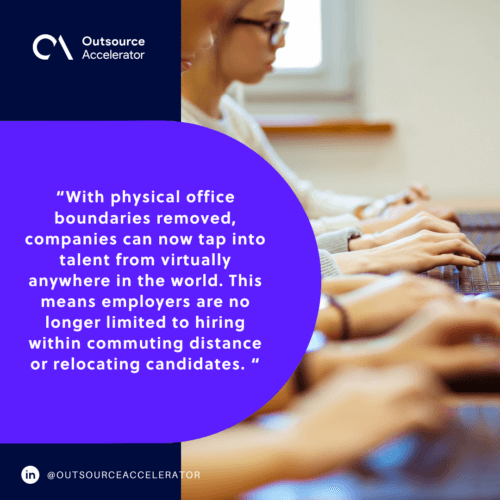The impact of remote work on global tech talent acquisition

In the past few years, the global workforce has undergone a dramatic transformation, particularly in the technology sector. Once considered a perk, remote work is now a standard practice for many organizations.
This shift has had far-reaching implications, especially in how companies source and hire talent. Tech talent acquisition—once limited by geography—is now a global game.
The rise of remote work has opened up new opportunities, redefined hiring strategies, and introduced both benefits and challenges for businesses seeking top tech professionals.
In the 537th episode of the Outsource Accelerator Podcast, Sergio Murillo of Coderland explains how his company stayed ahead of the curve by offering remote work.
This article examines how remote work proves to be an enticing tool for tech talent acquisition.
Remote work’s prevalence
The widespread adoption of remote work began as a necessity during the COVID-19 pandemic, but it quickly evolved into a permanent fixture in many industries. Tech companies were among the first to pivot successfully, thanks to their digital nature and agility.
This held true for Coderland as well, with Sergio saying that “The business model is 100% remote work. We were already prepared for the COVID situation.”
Today, remote work is not just a temporary solution—it’s a long-term strategy. According to the World Economic Forum’s report, remote global digital jobs are expected to grow to over 90 million roles by 2030.
According to various global workforce reports, a significant portion of tech roles are now fully remote or hybrid.
This trend has normalized distributed teams and encouraged companies to rethink their approach to tech talent acquisition, particularly across international borders.
The advantage of remote work in tech talent acquisition
Remote work has reshaped the playing field for hiring in tech. Here are five major advantages it brings to tech talent acquisition:
1. Access to a global talent pool
With physical office boundaries removed, companies can now tap into talent from virtually anywhere in the world. This means employers are no longer limited to hiring within commuting distance or relocating candidates.
They can find highly specialized professionals in regions where tech expertise is abundant but opportunities may be scarce. As a result, companies are filling roles faster and with better matches for their technical needs.

Sergio has noticed that “in the US and Canada, companies are looking for nearshore [workers]. They are really interested in working with outsourced developers in the same time zone.”
According to him, Coderland’s remote work opportunity “breaks down geographical barriers, offering businesses access to the best talent worldwide, specifically in Latin America.”
2. Greater diversity and inclusion
Remote work allows organizations to prioritize diversity in tech talent acquisition. Hiring globally naturally brings in professionals from different cultures, socioeconomic backgrounds, and perspectives.
This not only helps build more inclusive teams but also enhances innovation and problem-solving.
Companies that embrace remote hiring often find themselves with teams that better represent their global customer base.
3. Competitive edge in talent markets
Remote work can be a powerful recruiting tool. Top tech professionals often seek flexibility and work-life balance, and offering remote roles makes companies more attractive in competitive markets.
Organizations that adapt to this demand are more likely to attract high-caliber candidates who might otherwise be drawn to Silicon Valley giants or well-known startups.
4. Reduced hiring costs
Hiring remotely can also reduce expenses associated with relocation, office space, and salaries adjusted to high-cost urban centers. Companies can build efficient, cost-effective teams by hiring from regions with lower living costs, without compromising on skill level.
This can be particularly useful for startups and growing tech firms that need top talent but have limited budgets.
5. Faster scaling and flexibility
Remote work makes it easier for companies to scale their teams quickly. When you’re not constrained by location, the hiring process becomes more agile.
Tech talent acquisition becomes less about who’s nearby and more about who’s best for the job.
This flexibility is crucial in fast-paced tech environments where new product launches or platform expansions require quick hiring decisions.
Challenges and considerations in global tech talent acquisition
While the benefits are clear, remote work also introduces new hurdles in tech talent acquisition. Companies need to navigate several complex issues when hiring across borders:
1. Legal and compliance complexities
Hiring talent internationally means dealing with different labor laws, tax regulations, and compliance requirements. Without proper legal infrastructure or guidance, businesses risk non-compliance, which can lead to fines or legal disputes.
Partnering with global employment solutions providers or using Employer of Record (EOR) services is often necessary to mitigate these risks.
2. Communication and time zone barriers
While asynchronous work is common in remote settings, managing collaboration across multiple time zones can be tricky. Team meetings, project updates, and real-time problem-solving can become slower or more complicated.
In tech talent acquisition, this factor needs to be considered early in the hiring process to ensure that team dynamics and productivity won’t suffer.
This plays a big role in why Coderland mainly seeks clients in the same time zone as its developers.
“Good talent receives a lot of offers from different companies, and they don’t want to start the day working at 3 AM [when] another company [lets] them start at 10.”

3. Assessing cultural fit and soft skills
Evaluating a candidate’s technical capabilities remotely is relatively straightforward with coding tests or portfolio reviews. However, assessing cultural fit, communication skills, and emotional intelligence is harder when you can’t meet someone in person.
These factors are crucial in remote environments, where misunderstandings can easily arise without strong interpersonal skills.
Recruiters must adapt their hiring techniques, often incorporating more structured interviews and behavioral assessments.
The future of global tech talent acquisition
As remote work becomes more deeply embedded in workplace culture, tech talent acquisition will continue to evolve.
We can expect a greater reliance on AI-powered tools to help source, vet, and onboard candidates across time zones. Hiring platforms that incorporate video interviewing, automated skill assessments, and predictive analytics will become standard tools in recruiters’ toolkits.
Moreover, the concept of distributed teams is reshaping how companies structure their operations. Employers may start designing teams around time zones or specific project needs, rather than departments or office locations.
There’s also likely to be an increase in companies hiring fractional or freelance tech experts, further diversifying hiring models.
Organizations that invest in remote-first infrastructure, flexible policies, and global hiring expertise will be best positioned to thrive.
The competition for top developers, engineers, and IT professionals is intensifying. Consequently, remote work is no longer just a benefit—it’s a vital part of a winning tech talent acquisition strategy.
For Coderland, it aligns perfectly with their motto. As Sergio says, “People first [with] our developers. That’s our differentiation.”







 Independent
Independent




